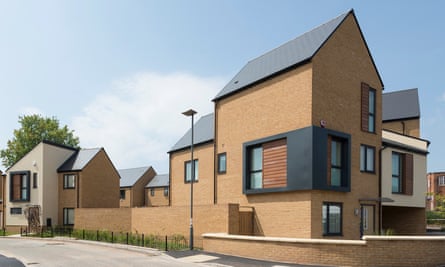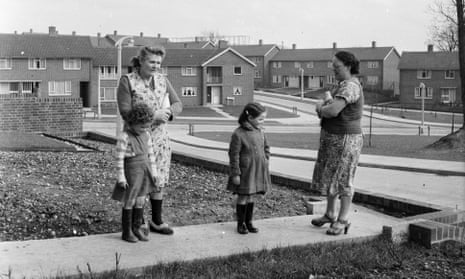There were two periods in the 20th century when housing supply did a reasonable job of meeting housing demand and need. The first was between the wars, when cities expanded horizontally into the suburban development of green fields and, assisted by government incentives, builders could offer affordable homeownership to people on middle-to-low incomes. The second was in the decades after the second world war, when publicly funded council housing accounted for roughly half of all homes built.
The first was largely ended by the nationwide introduction of green belts from the 1940s onwards, the second by Margaret Thatcher’s termination of local authorities’ power to build housing.
There’s an increasingly well-known graph that shows the effects of the latter in dramatic terms. From the late 1950s, private sector output is quite consistently within a range of 150,000 to 200,000 homes per year (a figure often given – which changes remarkably little over time – is that Britain needs 250,000 new homes a year.) Council housing brought the total up to a peak above 400,000 in the late 1960s, before tailing off through the 70s and 80s. As it does so, the rate of increase of house prices rises, at first slowly and then fast.
Housing associations took up some of the slack left by council housing, but mostly it was left to the private sector to fill the gap, which it didn’t do. Instead it plodded on at a similar rate to previously, before falling off a cliff following the 2008 crash, a dive from which it has not fully recovered.
This sluggishness is despite successive governments’ attempts to liberalise the restrictive planning that they say is to blame for poor supply. Short of a return to a 1930s free-for-all, and possibly not even then, the evidence seems conclusive that the market will not on its own provide. This is not because developers are wicked but because rational self-interest requires that they do not build so much as to flood their own markets, or to expose themselves to excessive risk.
It is now a reasonable question whether well-planned development in the nation’s green belt should always and in all circumstances be ruled out, but no one in their right minds wants to return to the land-eating, unsustainable sprawl of the 1930s. Which leaves the idea that local authorities again become major contributors to the country’s supply of new housing. It seems outlandish in the current political climate: unicorns and griffins might be spotted in Whitehall before government launches a huge state house-building programme.
But it is backed not only by the Labour party, which has promised a “substantial and sustained programme of public housebuilding”, and a possible 100,000 affordable public homes by 2020, but also by figures such as Lord Kerslake, the former head of the civil service and before that chief executive of the government’s Homes and Communities Agency. All the main candidates in the London mayoral election, including the Conservative Zac Goldsmith, have called for local authorities to be given more freedom to build. Possible measures include releasing restrictions on their ability to borrow against the future value of new homes and extension of powers of compulsory purchase.

There are counter-arguments. Conservatives are fond of a spurious statistic that Britain already has more social housing than most European countries, and therefore doesn’t need more: it ignores the fact there are different types of classification in different places, such that homes we would call “social” come under a different category in, for example, Germany.
The line that we only need infinite deregulation of planning, impossible though it is to achieve and for all that experience suggests otherwise, is still promoted. The planning system could indeed be more constructive, but the evidence is strong that government also needs to take a more active role in providing homes.
New council housing is even already happening, to some degree, due to a change in government policy that allowed local authorities to start building again, to a limited degree. In East Anglia, the not-Trotskyite district councils of Babergh and Mid Suffolk have combined forces to build their first new council houses in nearly 30 years. In Birmingham, in 2014-15, 28% of new homes were built by the council. London boroughs such as Brent and Hackney are building again. Camden has “a 15-year plan to invest in homes, schools and community facilities”, albeit one threatened by the current Housing and Planning bill.
Clive Skidmore, head of development at Birmingham city council, believes that years of undersupply have left the country short by about two or three million homes. He also argues that a shortage of public housing is leading to bizarre and wasteful level of expenditure on housing benefit: more than 95% of government spending on housing, or about £25bn a year, goes on helping people pay their rent, often to private landlords. The amount is still rising.
It would be much more productive, he says, if the same money went into building new homes, which would create long-term construction jobs and capital assets that would remain in public ownership. Local and national government can also borrow more cheaply than business and, while it may not achieve the same efficiencies as volume housebuilders, can reinvest in housing what they would take out as profit. Government is less vulnerable to risk, and better placed to build in recessions.
Christine Whitehead, professor emeritus of Housing Economics at the LSE, agrees that “major developers are doing what they’re doing and are not going to be able to do much more”, so “all other mechanisms have to be tried”. Local authorities can provide “different land, different finance, different people”. Kerslake says: “We need to double supply. Private housebuilders won’t increase their supply to get near to this figure, and it’s unwise to put all your eggs into building for sale, as it’s vulnerable to economic shiftsWe need mix of market rent, building for sale, and more building by housing associations and local authorities.”
To speak of large-scale public housing, whether built by local authorities or national government, is to raise memories that are not wholly positive, of silos or ghettos of the poor, of vast monolithic estates, of concrete monstrosities and in some cases local government corruption. It’s been widely pointed out in recent years that this period was not all dark and that successful, popular and beautifully designed council housing was also achieved from the 1950s to the 1970s, but even the most ardent revisionist should concede that mistakes were made.
It’s fair to ask whether they would be made again. Skidmore argues that “we don’t build monolithic housing estates that all look the same any more”. This is a result of belief and financial necessity. Most people now think it’s good to mix up different types of tenure. Housing for sale and at different levels of rent has to be mixed with rented homes for people on low incomes – what was traditionally considered to be “council housing” – to pay for the whole development.
When it comes to design, he thinks that local authorities can do better than the private sector. “We don’t do standard types. A Wimpey home can be the same in Glasgow or Cornwall or Manchester. We can respond to local conditions.” In principle, councils can take more care with landscaping and the spaces between buildings, as volume housebuilders have to strive more to compete on internal features, such as bathrooms and kitchens.
Skidmore also says that people who work for councils can understand their areas better than big developers, that they can have a “market intelligence” that “gives them an edge”. Private companies might look at a neighbourhood and see it only as “run down” and “not aspirational” without seeing that it has value for people for whom it is the location “of their family, their job, their friends, their place of worship”, but who “just want a better place to live”. He cites Newtown in Birmingham, whose reputation for drugs and gangs discouraged private investors. The council built homes there, which it managed to sell before completion, off plan.
Housing architects now are not, if they ever were, the modernist ideologues of legend. Whether they work for housing associations, developers or councils, the best of them are typically scrupulous and responsible, highly conscious of the importance of making successful open spaces, conditioned by the exacting demands of their clients to do a lot with a little.
You can look them up – Alison Brooks Architects, for example, Proctor and Matthews, Duggan Morris. At their worst the 1960s saw a lethal combination of poor quality industrial building techniques, abstract architectural theory and councils obsessed with quantity over quality. It does not have to happen this way again.
There are large obstacles to a renaissance of council-built housing, including but not only the obvious one of money. Claire Bennie, an architect and housing developer formerly of the housing association Peabody, says that councils should be allowed to borrow more, against the long-term value of their developments. Skidmore agrees, and also proposes the eventual diversion of housing benefit costs into bricks and mortar.

It is reasonable to ask if councils would be competent to become large-scale developers, given their patchy records, to which the honest answer would be that, as with any available option, public housebuilding is imperfect and there would be mistakes. Skidmore, however, believes that by working with private consultants, developers and contractors rather than directly employed building labour and architects’ departments, as in the past, risks can be greatly reduced. “It’s really not rocket science,” he says
Land – as these hundreds of thousands of new homes need to go somewhere –is an issue, as it is for the private sector, but one in which government might have an advantage. Much underused land – no one seems to know exactly how much – is owned by councils, the health service, the Ministry of Defence and other institutions. The main idea is to sell as much as possible to the highest bidder; alternatively it could remain an asset in public ownership and be actively used to provide housing at various levels of affordability.
A more daring proposition would be to use compulsory purchase powers to take over (for example) housing sites left undeveloped by their private owners. You don’t have to believe in a Soviet command economy to consider such measures. As Bennie points out, it is common practice in western Europe for local authorities to acquire and assemble sites, plan them, invest in remediation and infrastructure as necessary to make them viable, and then develop them partly themselves and partly through selling plots to developers.
For Whitehead, the biggest problem is the capacity of the housing industry: it doesn’t have enough skilled workers, whether on construction sites or in offices managing them, to build the hoped-for numbers of homes, nor the supply of materials and equipment to support them. Skidmore says that “you see a lot of grey hair on building sites”, as workers are getting older and closer to retirement, and not being replaced by a younger labour force.
Both blame the cycles of the building industry, which follow in exaggerated form the booms and busts of the economy as a whole. If you are a building contractor, you would be mad to invest in a workforce and facilities too extended to survive a recession.
If you are a young person considering a career in construction, you would be discouraged by the prospect of periods of unemployment every few years. Mass-production and industrialised building techniques – improved by 50 years of experience since the 1960s and now commonplace on office buildings – could help, but they also need long-term investment that is difficult in Britain’s bulimic construction economy.
Again, a large public building programme could in theory help. It could provide continuity, confidence, insurance against the effects of downturn. Private housebuilders could spread their risk by also working on public projects.
Unfortunately public projects come with their own risk, which is the electoral cycle and the caprices of successive governments. Skidmore thinks that it is at least a 10-year project to address the deficits left by previous housing policies, and therefore requires cross-party consensus on the subject of a kind that existed in the 1960s.
It is a big if. Long-term thinking and consensus seem more absent than ever from political discourse. One thinks of those unicorns and griffins again. Whitehead doesn’t sound convinced that such things could happen. But the alternative is ever more of the waste and misery caused by building too few houses, too badly at too high a cost.











Comments (…)
Sign in or create your Guardian account to join the discussion